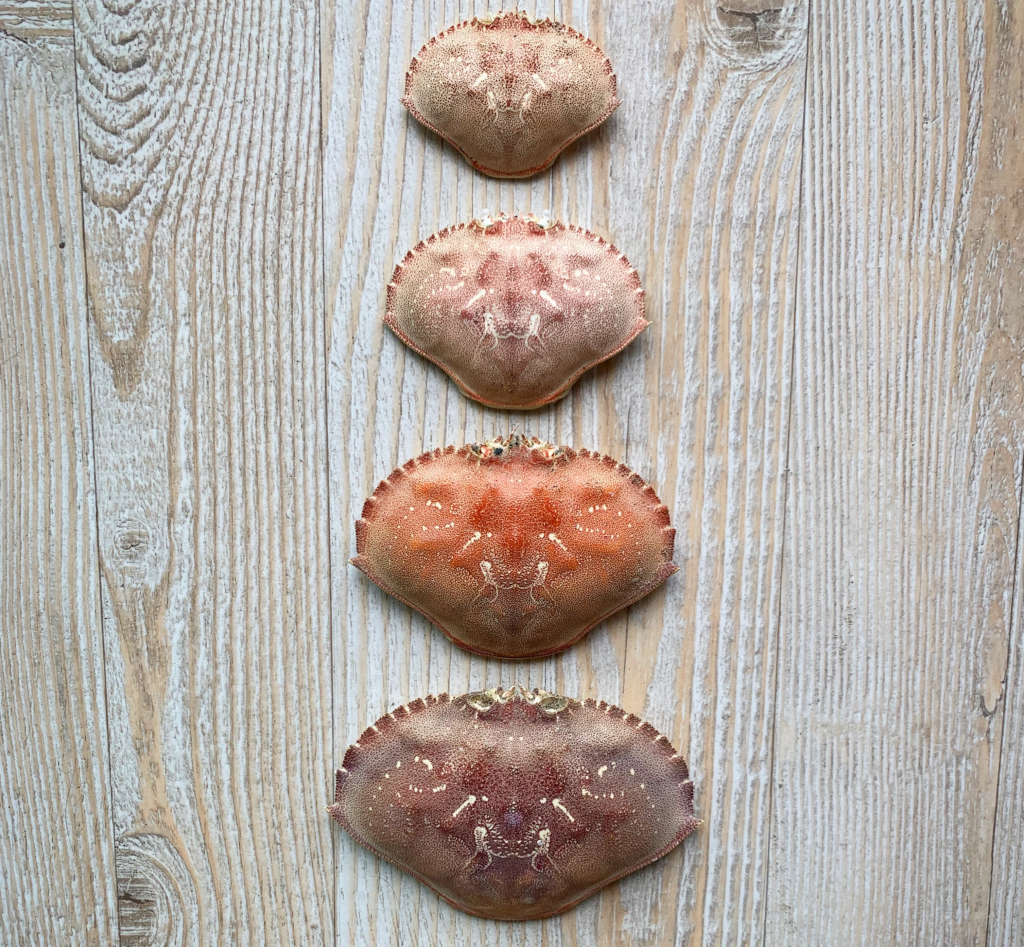
Ten days ago, my family and I drove to the Oregon coast to escape the Texas heat and the monotony of home. I was starting to feel a bit trapped.
The beach here is not like the beaches in Texas. The Pacific water is ice cold, and a bone-chilling wind whips at your hair and coat. It is violent and loud. Each day with the tide the sand is littered anew with strange, oceanic finds: driftwood, seaweed, seashells and shellfish, and here and there, whole crab shells.
The first one I found took my breath away with its perfect symmetry and intricate design. Its reddish orange hue faded to brown at its crimped edge. It was beautiful, fragile and thin in my hand. I loved it and immediately started looking for others, an activity my kids were quick to catch onto. It didn’t take long for Ellie to ask the obvious question: “where’s the rest of it?”
Crabs, I’ve since learned, undergo a molting process that is essential for growth. About once a year, a crab will shed its shell by casting it off. First, they grow a soft shell underneath, then they swell with water to break the outer shell, eventually backing out of it and leaving it behind. For a few days, the crab will be particularly vulnerable as its new shell hardens. But in this period the crab rids itself of parasites and grows stronger, even growing back missing limbs. Then, in a year’s time when its new shell starts to prevent its growth, it will be time to molt again.
This reminds me of a word I learned recently and loved: liminal. It comes from the Latin word limen for “threshold,” and it means “relating to a transitional or initial stage of a process; occupying a position at, or on both sides of, a boundary or threshold.” Anthropologically, liminality refers to people being in the ambiguous, disorienting middle part of a rite of passage, or societies in the midst of political or cultural change. Liminal times are marked by uncertainty and doubt, but they also offer opportunities for great transformation and unprecedented change.
God used liminal periods throughout the Bible to grow His people. For example, forty years passed from the time Moses fled Egypt to when God called him to return as Israel’s leader. In that desert time, he learned to shepherd. Fifteen or more years passed from the time David was anointed as Saul’s successor to when he was actually crowned king at the age of thirty. In that time, he hid for his life, but also learned to lead men and to trust God. Similarly, the Israelites spent forty years wandering the wilderness, having passed out of Egypt but not yet entering the Promised Land. In that time of hardship, they dealt with sin. We also see similar liminal periods in the lives of Jacob, Joseph, and many others–times when God used a particularly uncomfortable, disruptive, and vulnerable time for necessary growth and development.
Sometimes called “the crossing over space,” liminal times are seasons of waiting. While frightening or frustrating on their face, these are times believers can trust that God is at work. Richard Rohr, Franciscan friar and author, wrote that the liminal space is where we are most teachable, and described it as:
“where we are betwixt and between the familiar and the completely unknown. There alone is our old world left behind, while we are not yet sure of the new existence. That’s a good space where genuine newness can begin. Get there often and stay as long as you can by whatever means possible. It’s the realm where God can best get at us because our false certitudes are finally out of the way. This is the sacred space where the old world is able to fall apart, and a bigger world is revealed. If we don’t encounter liminal space in our lives, we start idealizing normalcy.”
Idealizing normalcy. That sounds familiar. No doubt 2020 is a liminal space.
But now I think of the Dungeness crab whose shell I hold in my hand. I can picture it now: the icy cold water rushing into her home, bursting it open at the seams, forcing her to crawl backward out of its confined spaces. She is deliberately pushed out and made vulnerable by the very same Creator who fashioned the one-of-a-kind pattern on her back. And what feels like certain death is really just a requisite for growth, as she leaves all she’s known for the space between.

A very good read.